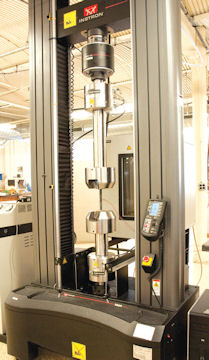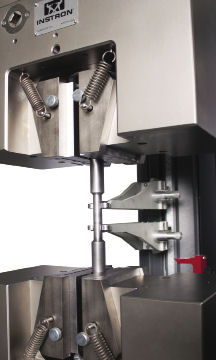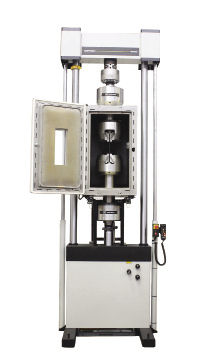August 1, 2013
With their distinct (laminated fiber) construction, composite materials have the capabilities to provide significant weight reduction in higher efficiency, energy-conscious applications. With proper design and validation testing, they frequently replace alternative materials, delivering higher reliability and solving other problems such as corrosion. Depending on the application, however—airplanes, automobiles or wind turbine blades, for example—extensive testing for tensile and other stress capabilities may be required.
Cases in Point
An award-winning thermoplastic composite horizontal tailplane is a main load-bearing primary structure of AgustaWestland’s twin-engine AW169 helicopter. Weighing 15% less than other composite solutions, this structure decreases both emissions and fuel consumption for the helicopter. The material also has inherent flame-retardant properties that allow it to meet stringent safety standards specified by the aircraft industry (see Fig. 1).
 Fig. 1: As a new generation of helicopter technology, the AgustaWestland AW169 horizontal tailplane has a length of 9 ft. and uses thermoplastic material, a high-performance engineering polymer and carbon/polyphenylene sulfide (PPS) semipreg and plate material. Image courtesy of AgustaWestland. |
Aerospace is just one of the industries taking advantage of the capabilities of advanced composite materials (ACMs) to change its products. The automotive industry also has composites high on its list of key materials for future vehicles:
BMW has identified carbon fiber reinforced plastic (CFRP) as its favorite lightweight material.
General Motors has replaced underhood components that are subject to a temperature environment as high as 302 °F with ACM. An aluminum component replaced with a glass-filled polyamide allowed the carmaker to shed between 7 and 9 lb. from a V6 engine. Every pound adds up quickly, so vehicle weight reduction is a key strategy for meeting emission regulations and reducing fuel consumption.
Testing Challenges
In fact, ACM is changing many industries. “Composite materials are lighter than metallic materials and have superior corrosion resistance. That leads to increased efficiency in aerospace, marine and automotive applications,” says Henry Patts, Ph.D., a materials engineer at Westmoreland Mechanical Testing & Research (WMT&R). “That’s why we’re getting significantly more interest in composites testing. I’ve been here for seven years, and it’s grown exponentially in that time.”
 Fig. 2: A universal tester measures tensile and other properties of composite materials for specified geometries. |
WMT&R deals with testing for a wide range of industries, and performs testing to meet the requirements of numerous industry standards. In business since 1967, WMT&R is one of the largest independently owned test labs in the world.
Because of their distinct laminated fiber and other reinforcing structural designs, different tests are required for composites. In addition to tensile strength, users are interested in modulus and strain, according to Kimberly Stuart, marketing and sales manager for Plastics and Composites Services at Intertek. Intertek provides quality and safety solutions including materials testing to several industries worldwide.
Intertek’s tensile testing services include a wide range of tensile test methods for a variety of composite constituents and materials applications (see Fig. 2). Some of these tests are defined and specified by ASTM International and the International Standards Organization (ISO). Elevated and reduced temperature tensile test procedures are available for tests such as:
- Tensile testing of polymer matrix composite materials ASTM D3039, ISO 527-5
- Tensile strength of sandwich constructions ASTM C297
- Tensile strength (open hole) of polymer matrix composite laminates testing ASTM D5766
- Tensile testing of plastics per ASTM D638 and ISO 527
 Fig. 3: Instron’s universal machine’s test results can be analyzed using the company’s BlueHill Software, which is compatible with several of its machines. Image courtesy of Instron. |
Unlike metals, the characteristics of these highly engineered materials are not nearly as well documented. “It’s not like we’re dealing with testing of 7050 aluminum or Inconel, where there is 100 years of history on it,” notes Charles Boyle, quality assurance inspection supervisor, WMT&R. “This is new stuff.”
One of the issues is predictability. “They don’t know what the values are usually for tensile strength, for bending strength, or for sheer strength—the typical properties,” Patts points out. “When we are assisting customers, one of the challenges to us is picking up where the customer might not be so knowledgeable about the tests that they are asking us to do, as it relates to their material.”
For example, a customer may need to test a unidirectional carbon fiber, high-strength modulus material using ASTM D695 or ASTM D6641 as the compression standard. “As a test engineer, you have to know that for unidirectional materials you have to reinforce those gripped ends or you are likely to get an unacceptable failure,” says Patts.
Being able to reliably perform the test is merely one aspect. With today’s increasing use of ACM, time is of the essence. To avoid longer-than-expected time-to-test results, service providers must have sufficient capacity to perform the required tests: Boyle advises that a 100-hour test run at a company with only two machines vs. a 100-hour test run at a company with 18 machines can provide significantly quicker turnaround, for example.
Tools of the Trade
Companies offering test services rely on equipment suppliers such as Instron, which provides testing equipment designed to evaluate mechanical properties of materials and components.
“The most important material to us now is composites,” says Ian McEnteggart, composite marketing manager at Instron.
Those who have strictly dealt in the testing of traditional materials have a few challenges as they move into the testing of ACM, he adds: “If you are coming from traditional materials, the key thing is that traditional metallics and polymers are essentially isotropic; their properties are the same in all directions.”
By contrast, long fiber ACM can be highly anisotropic; their properties can be highly directional. “That can be a huge advantage in design because you tailor the properties of the material to stress patterns in your composite,” says McEnteggart. “From a design point of view, although you have that power, you have a much more complex set of parameters required to define that material and to model.”
 Fig. 4: Instron hydraulic and electrodynamic fatigue testing machines allow customers to conduct fatigue tests. Image courtesy of Instron. |
With anisotropic materials, a large set of parameters is required for complete characterization. Not only are the materials anisotropic, they are two-phase. There are fiber, matrix and fiber-matrix bonding properties. As a result, a range of mechanical tests is required to extract information on all those different parameters.
“With a traditional material such as a metallic material, the majority of the testing that would be done is simple tensile testing,” says McEnteggart. “With complex materials, you need to perform tensile/multi-directional tensile tests. You need to conduct compression tests, shear tests and other specialist tests, like open hole bearing load tests.”
The starting point for ACM testing is a versatile universal test machine.
“A universal test system can be fitted with a wide range of test accessories, which conform to ASTM and also other standards to carry out that range of tests,” says McEnteggart.
In addition to multi-phase and anisotropic behavior, another aspect to these materials is their sensitivity to the environment. “They don’t rust, but they are sensitive to humidity,” explains McEnteggart. Usually the material is conditioned in the humid environment to absorb the moisture, and then tested at temperature but not under humid conditions.
While the universal tester can conduct the whole range of tests with the right fixturing, there are special considerations for the test processes.
“They are all fairly demanding,” says McEnteggart. “They do all require accurate alignment to apply the load in the right direction.” To accomplish this, the testing needs precise fixturing and, in some cases, a temperature-controlled environment, he cautions.
McEnteggart says he sees environment simulation, looking at the test environment more, fatigue testing, and greater concern for environmental factors, temperature and humidity as increasingly important factors for ACM.
“In addition to the static properties, there is a whole lot of complexity once you get into the world of fatigue,” he concludes. “Because the materials are complex, the matrix of possibilities is just enormous.”
Randy Frank is a contributor to DE. Send e-mail about this article to [email protected].
More Info
Subscribe to our FREE magazine, FREE email newsletters or both!
About the Author
Randy FrankRandy Frank is a freelance technology writer based in Arizona. Contact him via [email protected].
Follow DE





